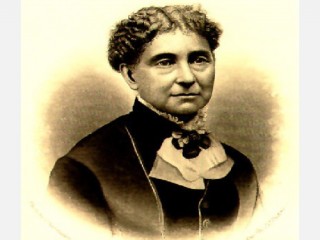
Amelia Jenks biography
Date of birth : 1818-05-27
Date of death : 1894-12-30
Birthplace : Homer, New York
Nationality : American
Category : Famous Figures
Last modified : 2010-11-26
Credited as : Advocate, woman's rights activist,
An American advocate of woman's rights in the early days of the feminist movement, Amelia Jenks Bloomer spent most of her life working for the cause. She was also a reformer of women's clothing and helped promote "bloomers."
Amelia Jenks was born into a family of modest means in Homer, N.Y., on May 27, 1818. Her formal education was negligible, consisting of only a few years in grammar school. At the age of 22 she married Dexter Bloomer, a lawyer and part owner of the Seneca Falls County Courier. A man of Quaker background and progressive social principles, he encouraged his wife to write articles on temperance and other social issues for his newspaper and for other periodicals.
In 1848, at the age of 30, Bloomer attended the first public Woman's Rights Convention at Seneca Falls, N.Y., but she took no part in the proceedings. A few months later she began to publish her own temperance newspaper, The Lily, which was immensely successful, gaining a circulation of 4,000 within a few years. At this time in her career Amelia Bloomer was a small, slight, dark-haired woman with good features and a pleasant expression. Timid and retiring by nature, she was a sternly serious person, seemingly lacking in any sense of humor.
Prodded by Elizabeth Cady Stanton, who also lived in Seneca Falls, Bloomer devoted increasing space in The Lily to questions concerning woman's rights, such as unequal educational opportunities, discriminatory marriage and property laws, and suffrage. In 1851 The Lily supported the reform in women's dress which came to bear Bloomer's name. Female fashion in the 1850s consisted of unhealthy, tightly laced corsets, layers of petticoats that could weigh well over 10 pounds, and floor-length dresses that dragged in the filth of the era's unpaved and unswept streets. The bloomer costume dispensed with corsets in favor of loose bodices, substituted baggy ankle-length pantaloons for petticoats, and cut the gowns to above the knee. Such a costume had been worn at the utopian New Harmony colony in Indiana in the 1820s and as resort wear during the 1830s, and Mrs. Bloomer was by no means the originator of the revival in 1851. But her promotion of it attached her name to the sensation. Woman's-rights advocates, such as Elizabeth Cady Stanton and Susan B. Anthony, wore the reform dress for a year or so but abandoned it when they concluded that the ridicule it frequently elicited was preventing a fair hearing of their views. Mrs. Bloomer continued to wear the dress until the late 1850s, but, conservative by nature (she never shared the liberal religious views or abolitionist sentiments of her sisters in the movement), even she eventually opposed bloomers as inexpedient.
Bloomer moved to Council Bluffs, lowa, in 1855, where she abandoned The Lily but continued to work actively in the woman's-suffrage movement of that state. She lectured and wrote widely, served as president of the state Woman Suffrage Association between 1871 and 1873, and corresponded with and arranged lectures for Lucy Stone, Susan B. Anthony, and Elizabeth Cady Stanton in lowa. She retired increasingly into private life in the 1870s, troubled by poor health. She died at Council Bluffs on the last day of 1894.
Amelia Bloomer's work never matched the incessant and selfless activity of some of her contemporaries, but she contributed to the suffrage movement far more profoundly than the generally facetious use of her name would indicate.
Bloomer's husband, Dexter C. Bloomer, published the Life and Writings of Amelia Bloomer (1895) shortly after her death. Most of the general works on the 19th century woman's suffrage movement take note of her. The most valuable work treating her career in some detail is Louise R. Noun, Strong-Minded Women: The Emergence of the Woman-Suffrage Movement in Iowa (1970). See also Eleanor Flexner, Century of Struggle: The Woman's Rights Movement in The United States (1959); Robert W. Smuts, Women and Work in America (1959); Aileen S. Kraditor, The Ideas of the Woman Suffrage Movement, 1890-1920 (1965); Andrew Sinclair, The Better Half: The Emancipation of American Women (1965); and William L. O'Neill, Everyone Was Brave (1969).
















